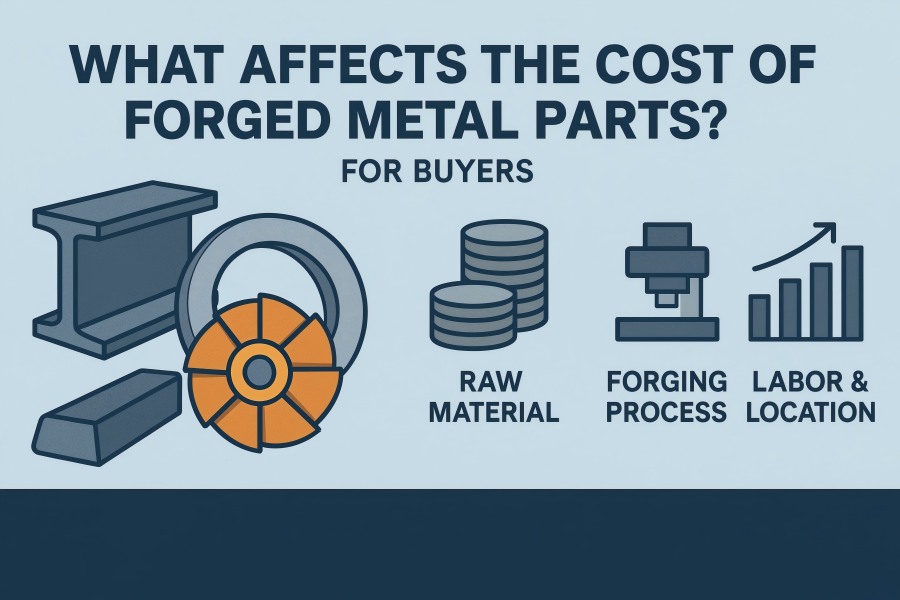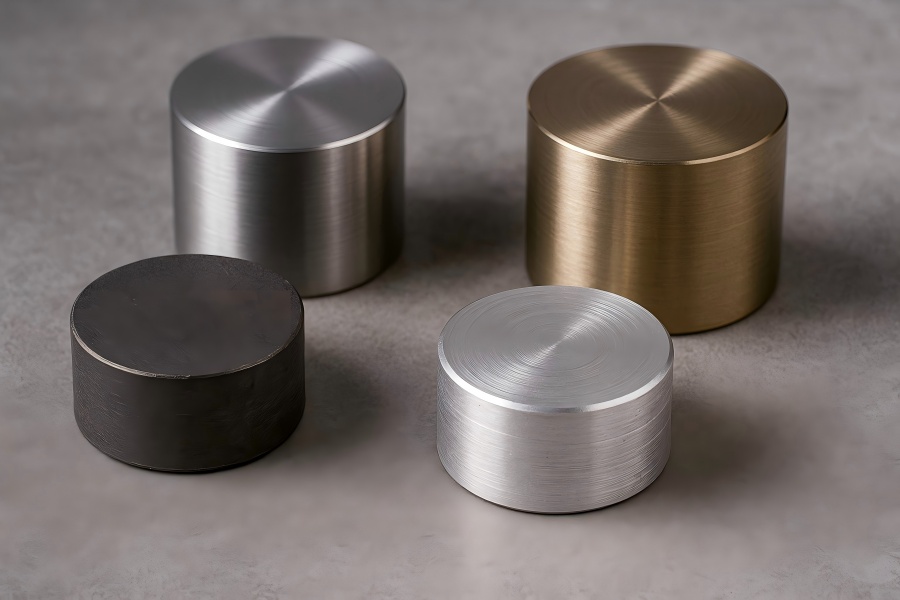Forged metal parts are critical components across nearly every industrial sector—but understanding their pricing remains a challenge. From aerospace turbines to heavy construction pins, cost variability can leave buyers wondering why seemingly similar components can carry vastly different price tags.
The main elements influencing the cost of forged parts are broken out in this thorough overview. Whether you’re sourcing new components, auditing a quote, or planning your next project, this article will equip you with the insights needed to navigate forging cost structures effectively.
Raw Material Selection
a. Metal Type Applied
The first and most immediate cost driver is the type of metal selected. Forging involves high-pressure deformation, and not all materials handle this process equally. Common metals include:
- Carbon Steel: Affordable, widely available, and used in general engineering.
- Stainless Steel: Corrosion-resistant, but costlier due to alloying elements.
- Aluminum: Lightweight and malleable, but needs specialized handling.
- Titanium & Superalloys: High strength-to-weight ratios, often 10x costlier than steel.
b. Metal Market Volatility
Global metal prices fluctuate due to geopolitical events, mining constraints, and demand surges (e.g., EV or aerospace booms). For example, titanium saw price spikes in the wake of sanctions and supply disruptions from key exporters.
c. Material Yield and Scrap
Net shape efficiency also impacts cost. Forging yields vary by design, and excess flash or trim increases waste. High scrap rates add significantly to material costs.
Table 1: Average Raw Material Price Comparison (2025)
| Material | Avg. Price ($/kg) | Common Applications |
| Carbon Steel | 0.80:1.20 | Structural parts, fasteners |
| Stainless Steel | 2.00:5.00 | Food, medical, oil & gas |
| Aluminum | 2.00:4.00 | Aerospace, auto, HVAC |
| Titanium | 20.00:30.00 | Aerospace, defense |
| Inconel (Superalloy) | 25.00:50.00 | Turbines, chemical plants |
Type of Forging Process
a. Open-Die vs Closed-Die Forging
Open-die forging (ideal for large, simple shapes) involves less tooling cost but often more machining. Closed-die forging uses custom dies to shape the metal precisely and is more expensive upfront due to die production.
| Process | Tooling Cost | Volume Suitability | Complexity |
| Open-Die | Low | Low to medium | Low |
| Closed-Die | High | Medium to high | High |
| Ring Rolling | Medium | Medium | Medium |
| Cold Forging | Very High | Very high volumes | High |
b. Hot vs Cold Forging
Hot forging enables complex shapes and reduces material hardness, making it easier to form. Cold forging yields tighter tolerances and better surface finishes but requires more force and costly dies.
Type of Forging Process
The choice of forging method greatly influences cost and suitability for different applications.
a. Open-Die Forging
- Ideal for large components.
- Lower die cost.
- Manual or CNC-controlled deformation.
b. Closed-Die (Impression Die) Forging
- High repeatability and dimensional accuracy.
- High tooling cost but low per-part cost at volume.
c. Rolled Ring Forging
- Used for bearing races, flanges, and gear blanks.
- High yield for circular components.
d. Isothermal and Hot-Die Forging
- Specialized methods for superalloys and aerospace parts.
- Requires temperature-controlled dies.
Table 2: Cost Comparison of Forging Processes
| Forging Type | Die Cost | Labor | Dimensional Accuracy | Suitable for |
| Open-Die | Low | High | Low | Shafts, billets |
| Closed-Die | High | Medium | High | Precision parts |
| Rolled Ring | Medium | Medium | High | Rings, bearings |
| Isothermal/Hot-Die | High | High | Very High | Aerospace, medical |
Tooling and Die Costs
Tooling is a major upfront investment. Closed-die forging requires high-precision dies typically made from tool steel and sometimes coated for longevity.
- Simple dies: $2,000–$10,000.
- Complex multi-part dies: $20,000–$100,000+.
Amortizing this cost over high-volume production reduces the unit price. For low-volume jobs or prototyping, this becomes a major cost hurdle.
Production Volume
Production volume has a direct and compounding effect on the cost structure. High-volume orders enable economies of scale by spreading fixed costs such as tooling, die setup, and engineering support over more parts.
For example:
- Batch heating of billets in high-volume runs reduces fuel consumption per unit.
- Continuous production minimizes equipment idling and changeover delays.
- Optimized labor allocation becomes feasible with repetitive tasks requiring less operator intervention.
As a result, a production run of 10,000 forged parts may cut unit costs by up to 50% compared to a 500-part batch, purely from operational efficiency, tooling amortization, and process repeatability.
Post-Forging Operations
Forged parts generally require secondary processes to meet dimensional, mechanical, and visual requirements. These post-forging operations vary in cost and necessity based on end-use and part complexity:
| Post-Process | Description | Cost Impact |
| Trimming | Removes flash or excess metal from edges | Low |
| Heat Treatment | Adjusts hardness, strength, and ductility | Moderate to High |
| Precision Machining | Achieves final tolerance and complex geometry | High |
| Surface Coating | Adds corrosion/wear resistance (zinc, phosphate) | Variable (low to high) |
| Testing & Inspection | Verifies dimensional and metallurgical quality | Moderate (varies by spec) |
If a part must undergo tight-tolerance CNC machining or multiple heat cycles, the post-processing cost can surpass the forging cost itself. High-spec parts (e.g., turbine blades or medical implants) are particularly prone to extensive post-processing demands.
Tolerance and Surface Finish Requirements
Tight tolerance requirements can exponentially increase costs. For instance, reducing a diameter tolerance from ±0.5 mm to ±0.05 mm may require:
- More complex dies with better thermal control.
- Intermediate machining steps and finish passes.
- Advanced inspection tools, such as coordinate measuring machines (CMM).
Similarly, surface finish standards like Ra < 0.8 µm (mirror-like surface) require multiple polishing, grinding, or lapping operations, which not only consume time but demand high-skill labor and specialized equipment. These aesthetic or functional finishes are common in aerospace, medical, and consumer electronics applications.
Labor and Manufacturing Location
Labor costs form a significant portion of total forging costs, especially for processes requiring manual billet handling, trimming, die changes, or post-processing.
| Country | Average Forging Labor Cost (USD/hr) |
| United States | $25:$45 |
| Germany | $30:$50 |
| China | $5:$15 |
| India | $3:$10 |
| Vietnam | $3:$8 |
Choosing offshore suppliers (e.g., in Asia or Eastern Europe) can significantly lower labor-related costs. These savings must be evaluated against any hazards, though, like:
- Longer shipping lead times.
- Communication and language barriers.
- Differences in quality control standards.
- Tariffs, customs duties, and geopolitical instability.
Thus, buyers often perform a Total Landed Cost (TLC) analysis before selecting a supplier location.
Energy and Utility Costs
Forging is energy-intensive. Hot forging requires substantial heating, and cold forging involves large presses. Factors affecting energy costs include:
- Local utility rates.
- Process efficiency.
- Equipment age and maintenance.
Certification and Compliance Requirements
Industries like aerospace, medical, nuclear, and defense require stringent regulatory compliance to ensure product safety, traceability, and performance. Meeting these standards adds overhead costs.
Typical certification and documentation expenses include:
- Quality System Certifications: ISO 9001, IATF 16949, AS9100, etc.
- Material Traceability: Mill test reports (MTRs), heat lot tracking
- Non-Destructive Testing (NDT): dye penetrant, magnetic particle, and ultrasonic
- Dimensional Reporting: First article inspections, PPAP submissions
These requirements often demand dedicated QA/QC personnel, specialized labs, and software systems, all of which contribute to higher part costs—particularly for low-volume custom parts.
Lead Time and Urgency
When parts are needed on an accelerated schedule, costs rise significantly due to disruptions in normal workflow and resource allocation.
Expedited production often requires:
- Overtime labor shifts
- Priority scheduling and equipment reservation
- Rush sourcing of materials (often at a premium)
- Faster shipping (air freight over sea freight)
Rush orders may cost 20–50% more than standard orders due to these expedited steps. In critical industries (e.g., automotive recalls, military needs), some clients willingly pay these surcharges for speed.
Packaging and Transportation
Forged parts—especially large, heavy, or precision components—require secure, often custom packaging to protect them during shipping.
Packaging Considerations:
- Crating and bracing for heavy parts.
- Vacuum-sealing or VCI bags for corrosion prevention.
- Foam inserts for impact-sensitive parts.
Transportation Considerations:
- Domestic vs. international shipping methods.
- Containerization, palletization, and lashing for sea transport.
- Freight insurance, taxes, and customs paperwork.
For large orders or huge forgings (such as hubs, axles, or flanges), transportation may be responsible for 10–30% of the overall cost of landing.
Vendor Capabilities and Reputation
Choosing a well-established forging vendor with advanced capabilities may come at a higher unit price—but often delivers value through:
- Lower rejection rates.
- More consistent mechanical properties.
- Faster delivery times.
- Better engineering collaboration.
Tier-1 suppliers typically maintain:
- In-house die design and maintenance.
- Integrated heat treatment and machining.
- Robust quality systems (CMMs, tensile testers, X-ray/NDT labs).
- Global customer support and documentation compliance.
Clients in high-risk industries often prefer such vendors to mitigate downstream quality or liability issues.
Inflation and Market Conditions
Metal forging costs are sensitive to global economic trends and raw material market fluctuations. Key influencers include:
- Commodity prices (steel, titanium, nickel, aluminum).
- Mining supply chain constraints.
- Energy prices (oil, natural gas, electricity).
- Geopolitical tensions or tariffs.
- Demand spikes from major industries.
In 2024–2025, price volatility in stainless steel and titanium was notable due to rising energy prices and limited ore extraction. Suppliers may include material price clauses in quotes, especially for long-term contracts.
Customization and Engineering Support
Customized forged components require early-stage engineering collaboration between the buyer and the manufacturer. These added services can significantly influence cost but are often critical to project success.
Common engineering value-adds:
- FEA (Finite Element Analysis) to optimize weight and stress distribution.
- DFM (Design for Manufacturability) consulting to reduce machining or simplify geometry.
- Rapid prototyping for test fit and function validation.
- Material substitution advice based on availability and performance.
These services may be bundled into the total cost per part or itemized, depending on the supplier’s pricing model. While upfront costs increase, long-term savings and performance improvements often justify the investment.
Making Cost-Smart Forging Decisions
Cost-effective forged metal parts don’t just come from choosing the lowest quote; they come from understanding what drives cost in the first place. By analyzing each cost factor—materials, forging method, tolerances, post-processing, vendor reputation, and supply chain dynamics—buyers can align their sourcing strategies with project needs, budget expectations, and long-term value.

